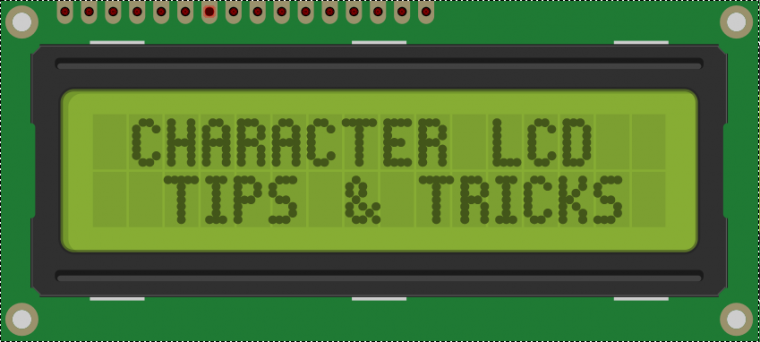

The issue I had on my emartee shield is that the pullup and the transistorĪre under the LCD which is soldered to the shield/board, which really limited what could It is also possible to alter the circuit on the shield however, The real solution is a different backlight circuit design. Overloading the Arduino pin which may eventually cause problems and perhaps Yes the backlight is on and it "appears" to be working but it is massively In those backlight circuit designs, the problem is that the Arduino pin is shorting to ground through the It was supposed to also turn the backlight on when D10 is HIGH. The 4.7k pullup turns on the transistor if D10 is an input and the transistor turns off whenĭ10 is low. The idea was that the backlight would be on by default and then pin D10 could control it. See the reference schematic (look closely at the transistor that controls the backlight) It is definitely an issue for these LCD keypad shields: While not as good as h/w fix, for many situations it can be "good enough".
#Arduino leonardo lcd display zip
Has been updated to contain a zip image (SWblCTL.zip) of some additional information Warning to users of some vendors LCD keypad shields - #2 by bperrybap - Displays - Arduino Forum Warning to users of some vendors LCD keypad shields - #99 by system - Displays - Arduino Forum

There has been 1 reported case of the test sketch not detecting the issue a Leonardo boardĪnd the Leonardo eventually being damaged after using the backlight. Warning to users of some vendors LCD keypad shields - #4 by bperrybap - Displays - Arduino Forum See response #3 for a safe alternative to using the sketch: The only safe way to verify this issue is to not use the Arduino to try to detect this issue. There is the possibility that running this sketch will damage the AVR on the Arduino board.

Since this h/w flaw in the shield is stressing the AVR way beyond its rated limits Warning to users of some vendors LCD keypad shields - Displays - Arduino Forum Warning to users of some vendors LCD keypad shields - #60 by bperrybap - Displays - Arduino Forum See this thread message for the test sketch: I have created a test sketch that will automatically detect if the shield has an issue. See this thread post for more information:
#Arduino leonardo lcd display download
Without level shifters you may destroy the display.You can download a sketch to test the h/w here:įor those that would like to do backlight control, you can use my hd44780 LCD library package (available in the IDE library manager) that supports backlight control and will auto detect this issue and work around the issue in s/w for shields that have the issue. Level shifters are required for all lines, which go to the display (SPI Clock and Data, A0 and CS, optionally the reset signal) They are mandatory to come down from the 5V of the Leonardo to the 3.3V of the display. How will you controll the display? You decided for a library already? Infact in many cases you even do not need the RC network and just applying 3.3V to the reset pin will also work. Yes, but for all pins: You need either a level shifter or the Leonardo must be a 3.3V version.īoth approaches are fine and i would call them equivalent. Am I right that A0 can be connected to any Leonardo pin?.It is also used to reset the communication if SPI is out of sync. The CS (chip select) which should be connected to Slave Select (or any other GPIO pin) is required for the communication. Yes, but - depending on the library - it might be any GPIO pin. Do I have to connect ALL the pins? I have only one device on SPI, so is it necessary to connect SS?.Thank You in advance for any help and suggestions! However on a scheamtic I found on the web it is clearly drawn that RESET is connected to 3V3 by a 10k resistor and to ground by 100nF capacitor: This pin should not be tied high or low or it may not be possible to reset the screen correctly." RESET - on it is written that "It is necessary to connect RESET to the microcontroller as the initialisation procedure involves toggling this pin. If it is essential to use SS - can I use any Leonardo pin to act as a SS?Īm I right that A0 can be connected to any Leonardo pin? page 20: "This is connect to the least significant bit of the normal MPU address bus, and itĭetermines whether the data bits are data or command.Ī0 = “H”: Indicates that D0 to D7 are display data.Ī0 = “L”: Indicates that D0 to D7 are control data." It's made by AV-Display and here is the connection schematic (at the bottom of the page) Wyświetlacze graficzne znakowe LCD OLED UART MONO TFT VFD LED - Artronic OPTOELEKTRONIKAĭo I have to connect ALL the pins? I have only one device on SPI, so is it necessary to connect SS? It is problematic in Leonardo, because it doesn't have SS output pin on board, as presented here Hello, I have Arduino Leonardo and my problem concerns SPI together with COG LCD with a ST7565R controller.


 0 kommentar(er)
0 kommentar(er)
